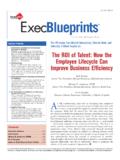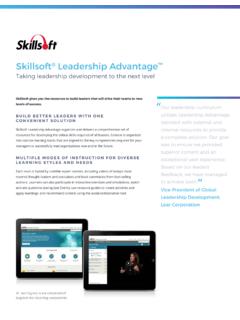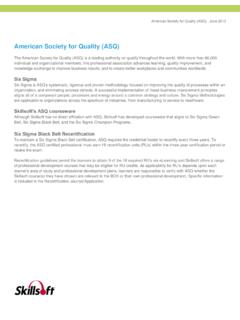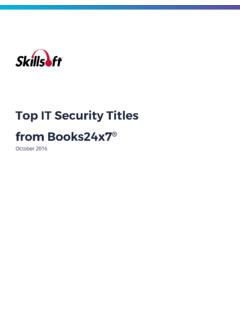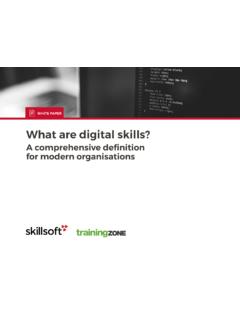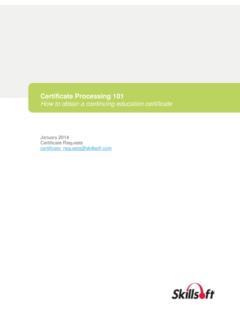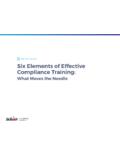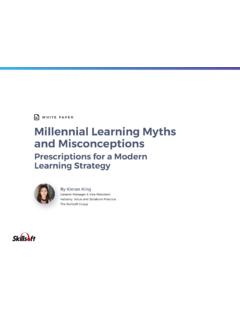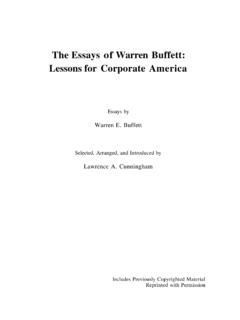Transcription of The Trust Edge - Skillsoft
1 CONTENTSI ntroductionPage 2 Part I: The Case for TrustPage 2 Part II: The Eight Pillarsof TrustPage 4 Part III: TransformingTrustPage 7 Rebuilding TrustPage 7 Part IV: Deep Trust in aFlat WorldPage 7 Trust in the Online AgePage 8 Part V: Courageous TrustPage 8by David HorsagerThe Trust EdgeHow Top Leaders Gain Faster Results,Deeper Relationships, and a StrongerBottom LineTHE SUMMARY IN BRIEFIn The Trust Edge, David Horsager reveals the foundation of genuine success Trust . Based on research but made practical for today s leader, The Trust Edgeshows that Trust is quantifiable and brings dramatic results to businesses and this book, Horsager teaches readers how to build the Eight Pillars of leaders learn how to implement these pillars, they enjoy better relation-ships, reputations, retention, revenue and results. Fascinating and timely, The TrustEdgeunveils how Trust has the ability to accelerate or destroy any business, organi-zation or relationship.
2 The lower the Trust , the more time everything takes, themore everything costs and the lower the loyalty of everyone involved. Conversely,an environment of Trust leads to greater innovation, morale and productivity. Thetrusted leader is followed. From the trusted salesperson, people will buy. For thetrusted brand, people will pay more, come back and tell others. Trust , not money,is the currency of business and life!IN THIS SUMMARY, YOU WILL LEARN: The enormous impact of Trust on your ability to succeed as a leader. How to identify and implement the Eight Pillars of Trust . How to extend Trust to others and rebuild Trust if it s been lost. The method to apply Trust in the difficult world of the digital economy. Why Trust can transcend cultural boundaries in Summaries 2013 Published by Soundview Executive Book Summaries 500 Old Forge Lane, Suite 501, Kennett Square, PA 19348 USA 2013 Soundview Executive Book Summaries All rights reserved.
3 Reproduction inwhole or part is prohibited. Concentrated Knowledge for the Busy May 2013 Order #35H-TFSI ntroductionIn 2009 at the World Economic Forum in China,world leaders got it right when they declared that ourbiggest crisis is a lack of Trust and confidence. We are ina Trust crisis, and organizations are slow to realize thebottom-line massive fraud in business to scandals in politicsand athletics, we re lacking in Trust . Meanwhile, theworld is flattening in many respects. Cultures aremeeting and expanding in ways that weren t possibleeven a decade ago. But globalization isn t a free megamergers and open markets have aroused newsuspicions and misunderstandings. We can reach acrossborders, but we don t know how to be trusted by thepeople we find on the other side. In the 21st century, Trust has become the world s most precious you visit the Roman ruins or the synagogue inCapernaum, you will see that many parts of the struc-tures have crumbled but the pillars still stand.
4 Pillarshold something up. They are strong, solid and the years I ve spent studying the underlying connec-tion between success and Trust , I ve identified eight keyareas that are best described as pillars. These pillars aresignificant for anyone interested in building support forgenuine matter what your role is, Trust affects your influ-ence and success. It has an impact at every level of busi-ness. Those who are trusted are responsibility for yourself. When you focus onincreasing your own Trust edge, you will enjoy greatersuccess and impact. When you change yourself, youhave the best chance of affecting your organization, yourfamily, your relationships and even your world. The Trust EdgeWithout Trust , transactions cannot occur. Withouttrust, influence is destroyed. Without Trust , leaders loseteams. Without Trust , people lose sales.
5 Without Trust ,organizations lose productivity, relationships, reputation,talented people, customer loyalty, creativity, morale,revenue and results. John O. Whitney, of the ColumbiaBusiness School, found, Mistrust doubles the cost ofdoing business. Trust DefinedTrust is a confident belief in someone or something. Itis the confident belief in an entity: To do what is right To deliver what is promised To be the same every time, whatever the circumstancesYou are trusted to the degree that people believe inyour ability, your consistency, your integrity and yourcommitment to Trust edge is the competitive advantage gainedwhen others confidently believe in it may appear to be static, in reality Trust ismore like a forest a long time growing but easilyburned down. Trust requires time, effort, diligence andcharacter. Inspiring Trust is not slick or easy to are two dimensions of Trust .
6 First, there is thedimension of time. This dimension goes from short tolong. Another dimension of Trust is depth. This dimen-sion goes from shallow to deep. Deep Trust is generallyestablished over time. Deep Trust often sprouts up quick-THE COMPLETE SUMMARY: THE Trust EDGEby David Horsager2 Soundview Executive Book Summaries author:David Horsager, , , is a business strategist, entrepreneur, professor and author who researches andspeaks on the bottom-line impact of Trust . His clients include Wells Fargo, ING and the Better Business Trust Edge: How Top Leaders Gain Faster Results, Deeper Relationships, and a Stronger Bottom Lineby David 2009 by David Horsager. Summarized by permission of the publisher, Free Press, a division of Simon and Schuster,Inc. 368 pages, $ , ISBN: 978-1-476-71137-9. To purchase this book, go to or Summary copyright 2013 by Soundview Executive Book Summaries , additional information on the author, go to by Soundview Executive Book Summaries (ISSN 0747-2196), 500 Old Forge Lane, Suite 501, Kennett Square,PA 19348 USA, a division of Concentrated Knowledge Corp.
7 Published monthly. Subscriptions starting at $99 per 2013 by Soundview Executive Book Summaries .Available formats:Summaries are available in several digital formats. To subscribe, call us at 1-800-SUMMARY (240-912-7513 outside the United States), or order onlineat Multiple-subscription discounts and corporate site licenses are also S. Clement, Publisher; Sarah T. Dayton, Editor In Chief; Andrew Clancy, Senior Editor; Amanda Langen, Graphic Designer; Corbin Collins, Contributing I: THE CASE FOR TRUSTly if a trusted source testifies that you are trustworthy. Icall this transferred Trust . Because A trusts B, and B trustsC, then A trusts Trust is deeply established, you will often begiven the benefit of the doubt instead of having everyaction judged with is not simply a dish in your leadership buffet. Itis the table holding up the smorgasbord of talentdemonstrated by your team every day.
8 When organiza-tions acquire the Trust edge, it shows in every relation-ship and eventually is proved by a growing bottom gives a concrete and critical advantage. Impact of TrustTrust, not money, is the currency of business and a climate of Trust , people are more creative, motivat-ed, productive and willing to sacrifice for the happens when the business gains the Trust edge?Every aspect of business becomes more will pay more, tell others and come suppliers whom you Trust , one call is time and costs decrease because there is lessdouble-checking, paperwork and High Cost of SuspicionSkepticism and suspicion create the opposite of trustand destroy motivation, teamwork and brings everything into question, slowsprocesses and promotes suspicion. America s public cli-mate has been pervaded by lack of Trust is your biggest expense.
9 As Trust dimin-ishes, procedures and laws increase, even for those whocan be trusted. Millions of dollars that could be used forresearch, staff training, or benefits and incentives arebeing spent on oversight and accountability processes toaccommodate more you re trusted, the less you pay. As trustgoes down, value goes down. As Trust in the markettanks, so does the value of the business. Without trustthere cannot be economic you happen to make a mistake that could erodetrust, sometimes stakeholders will see your mistake as anexception and continue to have complete confidence inyou. An extra measure of grace is commonly given tothose who have laid down a solid foundation of the rare occasion when a mistake is made, thosewho have the Trust edge are given the benefit of the earning the Trust edge, you will gain a significantadvantage that extends far beyond the bottom line.
10 Barriers to OvercomeTrust has decreased significantly over recent years. Astudy by Datamonitor found that 86 percent of con-sumers were less trusting of companies than they hadbeen five years ago. Fewer than two out of five employ-ees today have Trust or confidence in their senior overcome the barriers, let s first identify we know where they lie, we will overcome themusing the pillars. Barrier 1: Conflicts of existbetween shareholders and management, personalinvestors and banks, teachers and parents, and politiciansand the public, to name just a few. Barrier 2: Rising can stay shal-low. People are worried about whom they can Trust orwhat someone might do to them if they make a mistake. Barrier 3: Low Customer is lower than ever. People don t think of beingloyal. They think of themselves. People no longer feelloyalty from companies, either.
